Cervical cancer (C53)
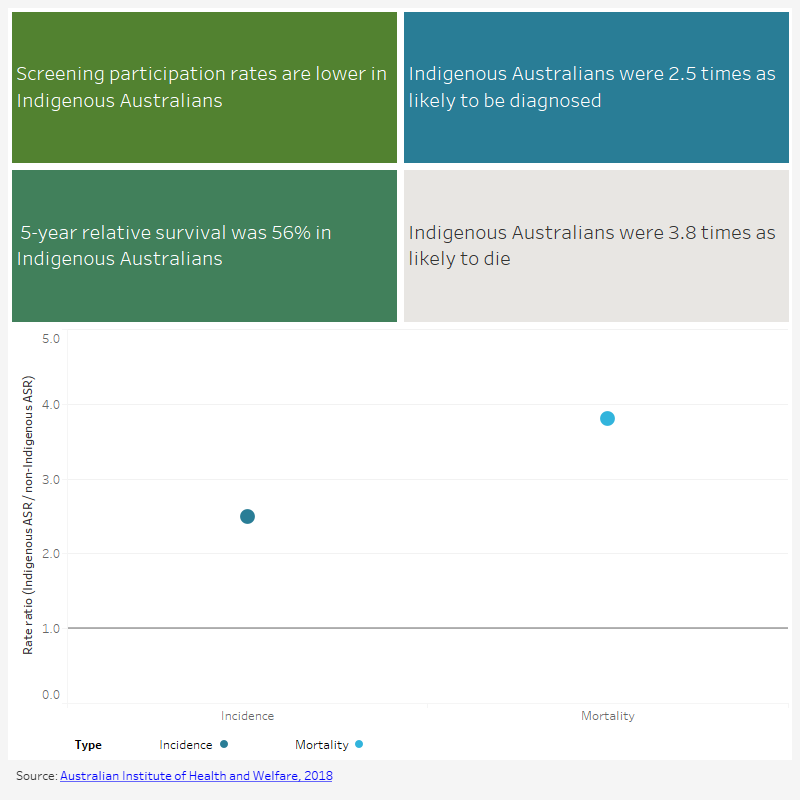
In 2009–2013, 150 new cases of cervical cancer were diagnosed in Indigenous Australians—an average of 30 cases per year. In 2011–2015, 56 Indigenous Australians died from cervical cancer—an average of 11 deaths per year.
In 2007–2014, Indigenous Australians diagnosed with cervical cancer had a 56% chance, on average, of surviving for five years compared with their counterparts in the Indigenous population. Non-Indigenous Australians diagnosed with cervical cancer had a 72% chance, on average, of surviving for five years compared with their counterparts in the non-Indigenous population.
Disparities in participation in cervical screening are likely to have effects on cancer incidence and mortality in Indigenous women. This is because cervical screening is able to detect precancerous abnormalities, thereby preventing cancers from developing and reducing the incidence of malignant disease. Cancers that are detected are also more likely to be at an earlier stage, which tends to be associated with better survival if treated.
Explore the data below for information on incidence (2009–2013), mortality (2011–2015) and relative survival (2007–2014).
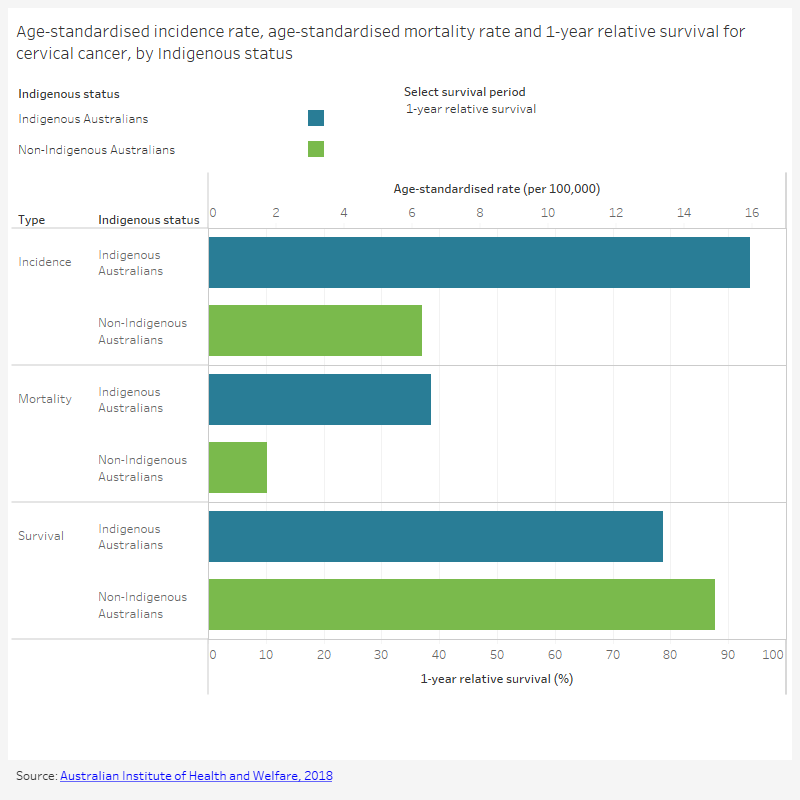
Life stage
For Indigenous Australians, the age-specific incidence and mortality rates for cervical cancer increased with each life stage. For non-Indigenous Australians, the age-specific cervical cancer incidence rate increased to life stage 25–44 and then decreased slightly, while the age-specific mortality rate increased with each life stage.
Due to small numbers, one-year relative survival is presented in text by life stage. For Indigenous Australians, one-year relative survival was higher for life stage 25–44 and lower for life stage 45–64. One-year relative survival for non-Indigenous Australians increased between 15–24 and 25–44 and then decreased with each life stage.
Explore the data below for information on incidence (2009–2013), mortality (2011–2015) and relative survival (2007–2014) by sex, Indigenous status and life stage.
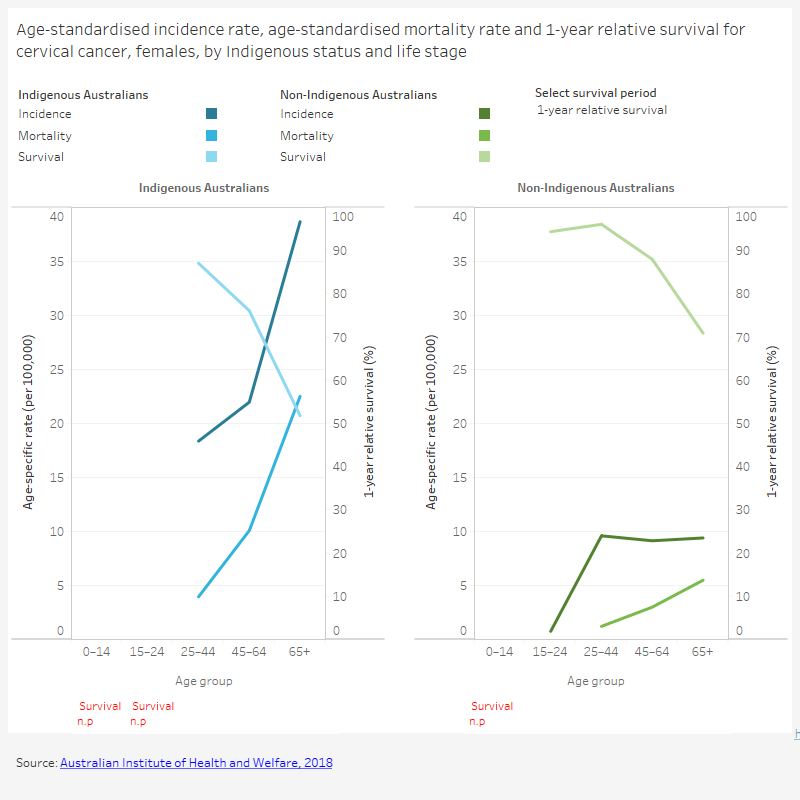
Trend
For Indigenous Australians, the age-standardised incidence and mortality rates for cervical cancer have varied over time. No statistically significant increasing or decreasing trend was observed in the cervical cancer incidence rate for Indigenous Australians from 1998 to 2013. Estimated trend lines indicate a significant decrease in the cervical cancer mortality rate for Indigenous Australians from 1998 to 2015.
For non-Indigenous Australians, the age-standardised incidence and mortality rates for cervical cancer decreased over time. Estimated trend lines indicate a significant decrease in the cervical cancer incidence and mortality rates for non-Indigenous Australians.
Data for individual years have been presented for trend figures to demonstrate the variation in rates from year to year. Estimated trend lines have been applied to figures based on a least-squares regression equation where trends were found to be statistically significant. Differences between the rates for Indigenous and non-Indigenous Australians may be related to a range of factors including differences between the two populations in the prevalence of risk and/or protective factors such as smoking, alcohol consumption, access to health-care services and uptake of screening and diagnostics testing.
Explore the data below for information on incidence and mortality by sex, Indigenous status and year.
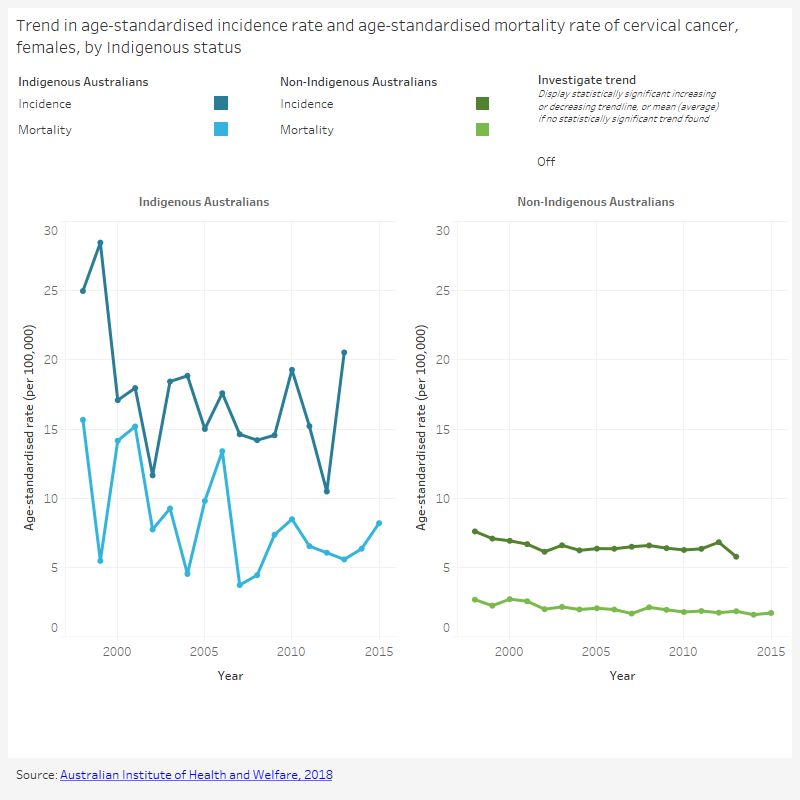
State and territory
For the jurisdictions for which data were available (see Summary or Notes section for details), the age-standardised incidence rate for cervical cancer ranged from 14 new cases per 100,000 to 23 per 100,000 for Indigenous Australians. For non-Indigenous Australians, the incidence rate ranged from 5.7 per 100,000 to 9.0 per 100,000.
For the jurisdictions for which data were available (see Summary or Notes section for details), the age-standardised mortality rate for cervical cancer ranged from 3.8 deaths per 100,000 to 12 per 100,000 for Indigenous Australians. For non-Indigenous Australians, the mortality rate ranged from 1.4 per 100,000 to 2.3 per 100,000.
Observed differences may be due to differences in population characteristics, for example, Indigenous Australians are more likely to live in remote areas of Australia than non-Indigenous people.
Explore the data below for information on incidence (2009–2013) and mortality (2011–2015) by sex, Indigenous status and state and territory.
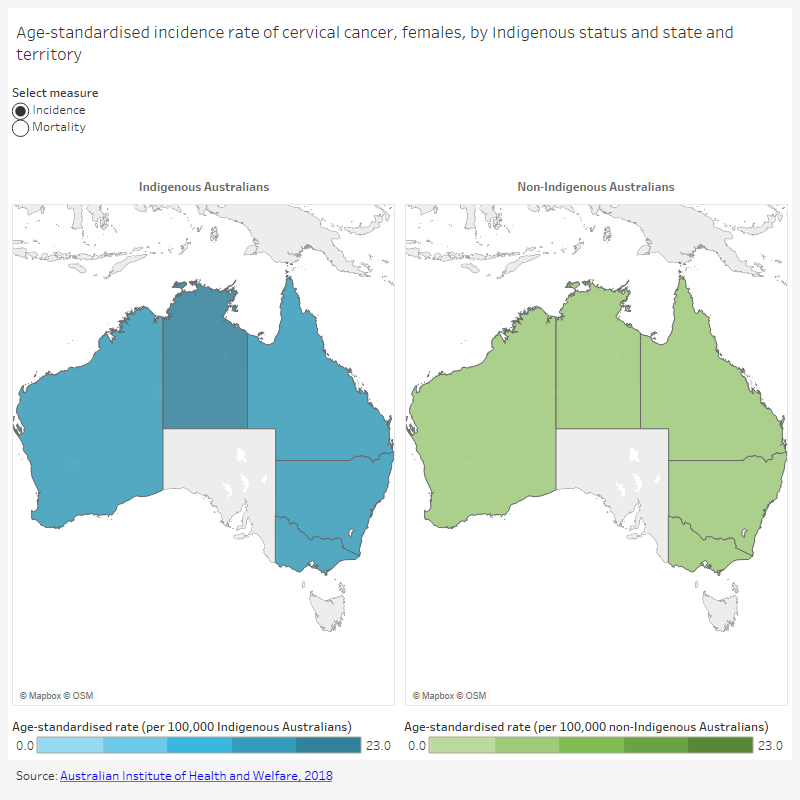
Remoteness area
For Indigenous Australians, the age-standardised incidence rate for cervical cancer ranged from 5.8 per 100,000 to 11 per 100,000 across remoteness areas. The age-standardised mortality rate for cervical cancer ranged from 2.3 per 100,000 to 4.1 per 100,000 across remoteness areas.
For non-Indigenous Australians, the age-standardised incidence rate for cervical cancer ranged from 3.1 per 100,000 to 3.7 per 100,000 across remoteness areas. The age-standardised mortality rate for cervical cancer ranged from 0.4 per 100,000 to 1.0 per 100,000 across remoteness areas.
Explore the data below for information on incidence (2009–2013) and mortality (2011–2015) by sex, Indigenous status and remoteness area.
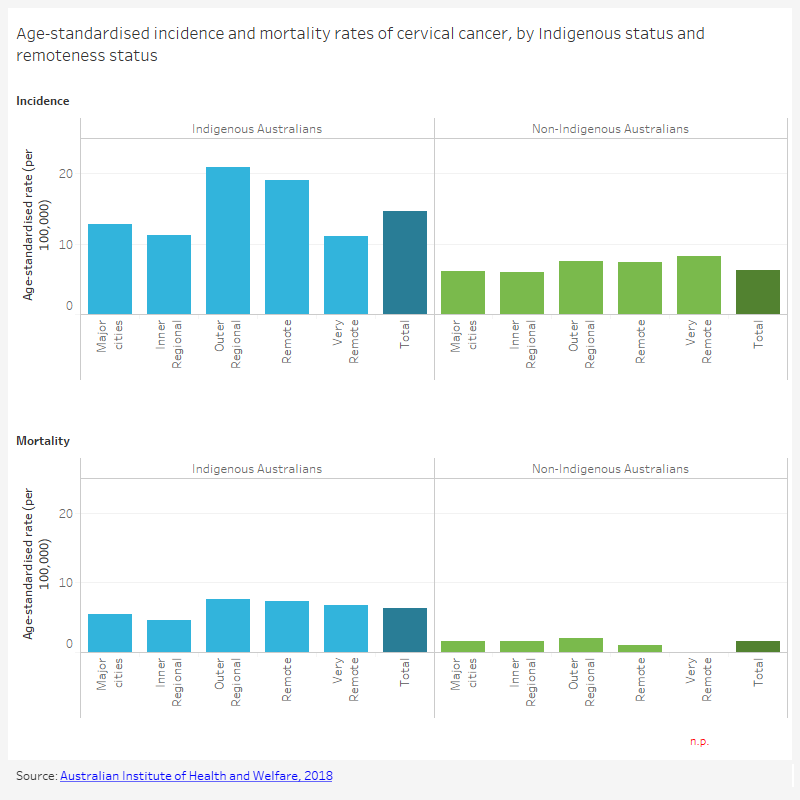
National cervical screening program
At the time of reporting, participation in cervical screening cannot be measured nationally for Indigenous women because Indigenous status is not included on all pathology forms in all states and territories—the only source of information for cervical screening registers.
However, there are some published data upon which we can draw. Coory et al. [1] and Binns & Condon [2] estimated participation in cervical screening in communities with high proportions of Indigenous women in Queensland and the Northern Territory, respectively. These studies found that Indigenous participation is lower than the overall participation rate for the respective state.
Whop et al. [3] used data linkage to transfer Indigenous status from the Queensland Health Admitted Patient Data Collection to data from the Queensland Health Pap Smear Register. It was found that 2-year participation was more than 20 percentage points lower for Indigenous women compared with non-Indigenous women for all reporting periods examined from 2000–2001 to 2010–2011.
The Indigenous primary health-care national key performance indicators (nKPIs) data collection indicates that 28% of regular female Indigenous clients aged 20–69 had a cervical screening test in the previous 2 years as at June 2016; 36% had a cervical screening test in the previous 3 years; and 44% had a screening test in the previous five years [4].
References
- Coory MD, Muller JM, Dunn NAM & Fagan PS 2002. Participation in cervical screening by women in rural and remote Aboriginal and Torres Strait Islander communities in Queensland. Medical Journal of Australia 177(10):544–47.
- Binns PL & Condon JR 2006. Participation in cervical screening by Indigenous women in the Northern Territory: a longitudinal study. Medical Journal of Australia 185(9):490–94.
- Whop LJ, Garvey G, Baade P, Cunningham J, Lokuge K, Brotherton JM et al. 2016. The first comprehensive report on Indigenous Australian women's inequalities in cervical screening: A retrospective registry cohort study in Queensland, Australia (2000–2011). Cancer 122 (10):1560–69.
- AIHW 2017. National Key Performance Indicators for Aboriginal and Torres Strait Islander primary health care: results from June 2016. National key performance indicators for Aboriginal and Torres Strait Islander primary health care series no. 4. Cat. no. IHW 177. Canberra: AIHW.


